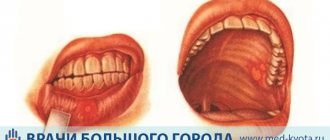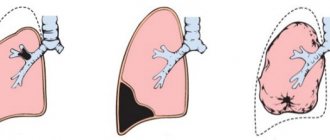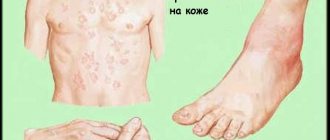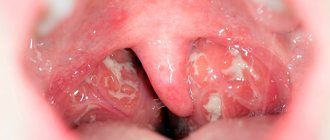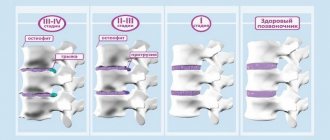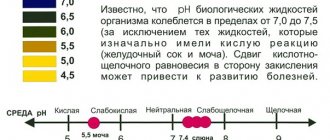Lacunar tonsillitis drugs: symptoms, treatment at home
- home
- Angina
02/18/2018 Lacunar tonsillitis is one of the types of disease in which inflammation of the palatine tonsils occurs.
The disease got its name because it is the lacunae that suffer primarily from the activity of pathogenic microorganisms that have penetrated the human oropharynx. According to the International Classification of Diseases (ICD 10), angina belongs to class X. J00 - J99 - “Diseases of the respiratory system.” Block: J00-J06 – “Acute respiratory infections of the upper respiratory tract.” ICD 10 code J03 – “Acute tonsillitis”.
Symptoms of lacunar tonsillitis
Symptoms of lacunar tonsillitis appear quickly within a day. Against the background of general malaise, the following signs of the disease are noted:
- body temperature rises to 39°C;
- worried about chills, weakness, body aches;
- pain when swallowing;
- submandibular lymph nodes become enlarged and painful;
- lower back, calf muscles, joints hurt.
Enlarged lymph nodes make it difficult to turn your head, and your voice may become nasal. When examining the oral cavity, enlarged tonsils, reddened palatine arches, and the posterior wall of the pharynx are noticeable. Lacunar purulent plaque appears on the tonsils. It is located in islands, which gradually merge and form a film. This condition corresponds to the average severity of the disease.
First signs and symptoms
The first and one of the main signs of a sore throat is a sharp rise in temperature
The first sign is always pain when swallowing the next morning. At first it may be a slight pain, then it increases. Lacunar tonsillitis is characterized by a purulent form and a sharp rise in temperature. Temperature values are usually high only on the first day; in subsequent days it can drop to less critical levels. A whole range of signs and symptoms of angina immediately appears:
- brokenness;
- drowsiness;
- signs of intoxication;
- lymph nodes under the lower jaw enlarge;
- the pain grows, simultaneously radiating to both the nose and ear;
- Possible vomiting or nausea. But this article will help you figure out what to do when you have a cough and nausea in the morning.
You can independently see the condition of the patient’s tonsils. The larynx is inflamed, the tonsils are covered with a dense, white coating. Sometimes you can see not the plaque itself, but the presence of purulent heads on each of the tonsils.
Less often, the plaque becomes extensive and blurs the boundaries between the tonsils; a person sees only the plaque itself. After a few days it begins to disappear if the person has started treatment.
Diagnosis of lacunar tonsillitis
Diagnosis of lacunar tonsillitis begins with an examination of the oral cavity. Based on the clinical manifestations, the doctor suspects a bacterial, viral or candida infection. Laboratory diagnostics allows you to confirm the diagnosis and choose the right treatment. The following diagnostic methods are used:
- express diagnostics – enzyme immunoassay with 2nd generation tests;
- bacteriological method - culture of tonsil discharge with a negative rapid test;
- PCR diagnostics allows you to accurately determine the causative agent of the disease.
A general blood test reveals changes characteristic of acute inflammation. But this diagnostic method does not help determine the causative agent of the disease, and therefore is considered uninformative.
In severe cases of pathology, a general urine test is necessary. If protein, red blood cells, or epithelial cells appear in the results, this indicates kidney damage.
Virological testing and blood serum analysis to detect antibodies to viruses are not used. The result of this method does not affect the choice of treatment tactics.
If streptococcal tonsillitis is suspected, it is not recommended to determine the concentration of antistreptolysin-O. This protein increases in the blood on days 7-9 of the disease, so it cannot be detected in the initial stage.
Diagnostics
The doctor will make a diagnosis of “lacunar tonsillitis” quite quickly, only after carefully examining the pharynx and the condition of the tonsils and tonsils
Diagnosis is based on a person’s complaints and visual examination of the larynx. Using a special spoon, the doctor presses the tongue at the very uvula. This allows you to carefully examine the pharynx and the condition of the tonsils and tonsils. Usually the nose is additionally examined for adenoids. The diagnostic procedure is not difficult even for novice doctors due to the obviousness of the signs.
From this article you can understand what a sore throat looks like in a child.
The contents of the article will help you figure out what to do about it; your throat hurts; it hurts to swallow.
What to do when your throat and ear hurt on the left side is indicated here in the article: https://prolor.ru/g/simptomy-g/bolit-uxo-gorlo-s-odnoj-storony.html
Lacunar tonsillitis is similar to diphtheria. If the doctor has suspicions, he will take a smear test to accurately determine the pathogen.
Lacunar tonsillitis in children and its features
Lacunar tonsillitis in children and its features are associated with the reactivity of the child’s body and the predominant type of infection. In children under 5 years of age, viral lesions of the tonsils often occur, which cause:
- adenovirus;
- Coxsackie virus;
- measles.
Bacterial tonsillitis in children is caused by hemolytic streptococcus. Up to 2 years of age, streptococcal tonsillitis rarely occurs. Infection occurs from a sick person or a carrier of infection during close contact.
In children, the disease occurs with severe intoxication; the main symptoms include nausea, vomiting, loss of appetite and complete refusal of food. Sometimes indigestion occurs, which manifests itself as diarrhea and abdominal pain.
Weak children are more likely to experience complications:
- myocarditis;
- polyarthritis;
- glomerulonephritis.
If you refuse to take antibiotics or start treatment late, children develop false croup - swelling of the larynx interferes with breathing and causes a dry, barking cough. This condition is life-threatening for the child.
Symptoms
Sore throat can occur in both adults and children. The disease has the peculiarity of bilateral damage to the lacunae and tonsils. It is rare for the infection to affect only one side.
Signs of the disease:
- Strong change in body temperature up to 39 - 40 degrees
- Pain in the oropharynx, feeling of the presence of a lump or foreign body
- Swelling and pigmentation of the tissues of the infected mucous dermis
- The appearance of purulent formations in the area of inflamed tonsils
- Swelling of the lymph nodes in the neck and ears, pain on palpation
- Chills, feverish state
- Minor pain in muscles and joints
- General deterioration of condition, headache
The local status of purulent lacunar tonsillitis is always accompanied by yellow-white formations on the tonsils. The occurrence of purulent plugs occurs due to the high secretion of leukocytes to fight pathogenic bacteria. The swallowing process is significantly complicated due to swelling of the oropharynx. The digestive tube is reduced in size, resulting in discomfort when eating and drinking.
Features of lacunar angina:
- There is a possibility of asymptomatic progression
- Caused by bacteria
- Can become chronic with frequent relapses if left untreated
- Characterized by purulent plaque on the tonsils
If these signs are present, then fungal or viral infection of the tonsils is excluded.
Main types of sore throat:
- Catarrhal is the mildest stage of the disease, accompanied by inflammation of the mucous surfaces of the oral cavity. There is a thin purulent film on the tonsils.
- Follicular - accompanied by the appearance of blisters with pus in the tonsil area.
- Lacunar is the most severe stage of angina, in which the pustules merge into large purulent formations and plugs form.
Thus, the difference between follicular angina and lacunar angina is that the second is a continuation of the first in the absence of timely and correct treatment.
Lacunar tonsillitis in adults and its features
Lacunar tonsillitis in adults and its features are associated with the gradual development of resistance to viral infection. The peak incidence of bacterial tonsillitis occurs in adolescence. Then the frequency decreases, after 45-50 years the pathology practically does not occur.
Adults tolerate the disease more easily than children. At an older age, the digestive tract is not affected, and there is no difficulty breathing. But if you ignore the symptoms of the disease and do not start treatment, the infection will spread to the retropharyngeal space. An abscess forms in it, which requires surgical treatment.
Causes of the disease
Photo of tonsils with lacunar tonsillitis.
The pathological process occurs most often in the autumn-winter period. Being near a sick person is dangerous. Purulent lacunar tonsillitis is a contagious disease that is transmitted by airborne droplets: by sneezing, coughing, talking, through various objects (toys).
Pus-filled lacunae are most often observed in the palatine tonsils. The causative agents of the disease are mainly beta-hemolytic streptococci. Also due to pneumococci, Klebsiella, staphylococci, Haemophilus influenzae.
In addition, the lacunar form of tonsillitis may initially be caused by viruses (adenoviruses, enteroviruses). They reduce the body's resistance, which is why microorganisms actively begin to multiply on the mucous membrane of the tonsils. Viruses themselves do not cause a sore throat; they can only weaken the immune system (local and general). If you have a strong immune system, the disease appears less frequently, and therapy proceeds easier and faster. People with diabetes, rheumatism, chronic sinusitis, caries, tuberculosis, and periodontal disease have a higher risk of infection.
In children, the disease is observed after a primary association with various strains of staphylococcus and streptococcus. Acute lacunar tonsillitis can form due to:
- hypothermia or drinking cold drinks or food;
- reducing the overall resistance of the body;
- congenital insufficient development of the tonsils;
- humidity or sudden changes in pressure;
- stress, overwork;
- general air pollution (industrial waste, dust, gas);
- chronic diseases of the ENT organs.
This happens because microorganisms remain in the center of chronic infection in the body (sinuses, teeth, nasopharynx, gums), from here they enter the tonsils.
Lacunar tonsillitis in adults often occurs due to regular irritation of the mucous membranes with cigarette smoke, drinking alcoholic beverages, and in children - due to inadequate treatment of acute tonsillitis.
Treatment of lacunar tonsillitis
Treatment of lacunar tonsillitis depends on the pathogen and the severity of the symptoms of the disease. Non-steroidal anti-inflammatory drugs are used to reduce fever and reduce pain. Paracetamol and Ibuprofen are allowed in children. These medications are also effective in adults.
For viral infections, antiviral drugs are used and rinses with antiseptic solutions are prescribed. Tonsillitis caused by a fungus is treated with Fluconazole, and the throat is treated with Lugol's solution. Bacterial tonsillitis is treated with antibiotics. Streptococci are sensitive to penicillins, so the doctor chooses from the following drugs:
- Phenoxymethylpenicillin;
- Amoxicillin;
- Benzathine benzylpenicillin;
- Amoxiclav.
For allergies to penicillins, cephalosporins are prescribed:
- Cefuroxime;
- Cefixime;
- Cefditoren.
If it is impossible to use drugs from the first two groups, treat with alternative antibiotics:
- Erythromycin;
- Azithromycin;
- Clarithromycin;
- Josamycin;
- Midecamycin;
- Spiramycin;
- Clindamycin;
- Lincomycin.
The dosage and dosage form are selected by the doctor individually depending on the patient’s age and the severity of the disease.
Antibacterial therapy is complemented by local treatment. Chlorhexidine, Furacilin, Miramistin, Biclotymol, and iodine preparations are used for rinsing. But with a bacterial infection, you cannot limit yourself to local treatment only.
Homeopathic remedies are allowed as part of complex therapy, but their effectiveness has not been proven. Photos of lacunar tonsillitis in children and adults
Treatment of lacunar tonsillitis with folk remedies
Treatment of lacunar tonsillitis with folk remedies is auxiliary. It helps relieve some symptoms and alleviate the condition, but will not eliminate the infection. Traditional medicine offers the following recipes for gargling:
- chamomile or calendula decoction;
- aqueous solution of aloe juice;
- 1 tsp soda dissolved in a glass of warm water;
- mixture 2 tbsp. l. apple cider vinegar with a glass of water.
Healers suggest chewing 2 g of propolis 3 times a day or lubricating a sore throat with its tincture.
Treatment options
The main thing in the treatment of lacunar tonsillitis is an integrated approach! Dieting is no exception; some foods can irritate the tonsils and complicate the course of the disease!
How and with what to treat the disease? Whatever the sore throat, lacunar or follicular, the therapy is almost the same. Effective treatment of lacunar tonsillitis in adults and children is based on compliance with the general regimen. Until the temperature decreases, you must remain in bed. This, together with drug treatment, will help to quickly cope with the disease and prevent possible complications. Therefore, at the first similar symptoms (redness and enlargement of the tonsils), you should contact a specialist who will prescribe the correct treatment.
It is possible to cure the disease with medication and local methods. During the course of the disease, you should adhere to a certain diet: drink plenty of fluids, do not eat salty, spicy, or pickled foods (they can irritate the tonsils and provoke even more swelling). It is necessary to eliminate allergic foods (chocolate, nuts, sweets, etc.) from your diet - they can increase the swelling of lymphoid tissue.
Local therapy
Often a soda-salt solution is used to gargle.
Purulent lacunar tonsillitis is treated with local remedies:
- Rinse. To get rid of microorganisms, gargle with antiseptic solutions (Chlorhexidine, hydrogen peroxide, Miramistin, boric acid, etc.). It is good to use solutions of salt, soda, infusions of oak bark, and sage for rinsing.
- Inhalers. It is very effective to use inhalers (Bioparox, Ingalipt, Tantum Verde).
- Lugol. Lubricate the throat to disinfect the tonsils.
- Absorbable tablets with antiseptic effects (Falimint, Sebedin, Gramicidin, Strepsils).
- Physiotherapy (UHF, microcurrent treatment).
Drug treatment of sore throat
Therapy includes the following methods:
- Antibiotics for lacunar tonsillitis are simply necessary. The most effective with regard to staphylococcus and streptococcus are penicillin-type antibiotics for sore throat (if you are not allergic to them). It is possible to use cephalosporins (Suprax, Ceftriaxone) and macrolides.
- Antipyretic drugs (Aspirin, Panadol, Paracetamol, Efferalgan, Nurofen).
- Antihistamines (Suprastin, Diazolin, Tavegil). Helps reduce swelling and also alleviate pain when swallowing.
- Multivitamins to boost immunity.
- Immunostimulants (Ribomunil, etc.).
- Antiviral drugs (Arbidol, Cycloferon), in the presence of viral tonsillitis.
Antibiotics for sore throat should be taken for a week, even if the condition has improved. After finishing taking antibiotics, you need to drink lactobacilli and bifidobacteria to replenish the intestinal microflora.
To avoid the appearance of any form of sore throat, you need, first of all, to strengthen your immune system, walk in the fresh air, take vitamins, do therapeutic exercises and not get too cold. ()
Recommendations for lacunar tonsillitis
Recommendations for lacunar angina include rules for action during illness:
- if a sore throat or dry cough appears in children, expectorants should not be given, they will lead to the appearance of sputum, which cannot be released and will worsen the condition;
- for symptoms of false croup in children, cold, humidified air is needed;
- The physician must differentiate streptococcal tonsillitis from mononucleosis to avoid treatment with amoxicillin. This antibiotic is contraindicated in viral mononucleosis;
- Antibiotics are mandatory for bacterial infections and should not be prescribed for prophylactic purposes for viral diseases;
- If the fever persists for more than 3 days during treatment, you need to replace the antibiotic or conduct additional diagnostics to clarify the causative agent of the disease.
It is not recommended to exceed the dosage of solutions or the frequency of gargling per day. Local antiseptics are toxic and can lead to adverse reactions.
Complications
Inflammation of the ears is one of the unpleasant complications of lacunar tonsillitis.
Delaying treatment will lead to the development of secondary diseases and severe processes:
- swelling of the entire larynx;
- ligament damage;
- laryngitis;
- inflammation of the ears;
- kidney damage;
- sepsis.
Question answer
Is it possible to remove pus from lacunar tonsillitis?
It is dangerous to remove purulent deposits on your own with a cotton swab or spatula; you can injure the inflamed tonsils. Doctors recommend gargling with antiseptic solutions.
Lacunar tonsillitis: can it be cured without antibiotics?
Acute tonsillitis cannot be treated without antibiotics. This will lead to the spread of infection to adjacent tissues and the formation of a retropharyngeal abscess. If streptococci penetrate through the blood into the myocardium, kidneys or joints, severe damage to these organs will occur.
Lacunar tonsillitis: can you be cured by the sun?
Ultraviolet light will not affect bacteria in the mouth. Their activity can only be suppressed with antibiotics.
Can lacunar tonsillitis occur without fever?
In rare cases, the body may not respond with an increase in temperature. But this does not mean the course of the disease is mild; the risk of complications remains.
Lacunar tonsillitis: is it possible to go to work?
The disease is accompanied by intoxication and fever and can lead to serious complications. This condition cannot be tolerated on your feet. The sick person becomes a source of infection and can infect others. Therefore, you need to stay home while you are sick.
Complications and prevention
In the absence of timely treatment, lacunar tonsillitis can lead to complications.
Possible consequences:
- Purulent tissue lesions without clear boundaries
- Inflammation of the ear canals, accompanied by purulent discharge
- Chronic tonsillitis with frequent relapses
- Inflammation of the lymph nodes
- Breathing complications due to laryngeal edema
In addition, angina can lead to sepsis and changes in the functioning of internal organs, the recovery of which will be quite difficult.
Prevention
Prevention of the disease includes following certain recommendations. Compliance with them will help minimize the possibility of developing the disease or its recurrence.
Adviсe:
- Maintaining personal hygiene
- Timely treatment of diseases of the oral cavity, gums, teeth
- Monitoring the function of full breathing through the nose - treatment of congenital pathologies, use of vasoconstrictors during the period of illness
- Regular exercise, strengthening the body
- Walking in the fresh air, ventilating rooms
- Protected contact with a person suffering from lacunar tonsillitis
- Supporting the body with vitamin and mineral complexes.
Disease prevention
Preventive measures for lacunar tonsillitis mainly consist of actions taken to strengthen the immune system.
After just suffering from an illness (especially in the cold season), before going outside, it is advisable to lubricate the nostrils with oxolinic ointment to prevent the development of secondary infectious diseases.
If possible , you should try to get rid of bad habits such as smoking and drinking alcohol.
At any time of the year it is advisable to take vitamin complexes , and include foods rich in beneficial microelements in your diet.
Prevention
There are several ways to avoid sore throat:
- First of all, this is the prevention of colds - you need to dress according to the weather, avoiding hypothermia or overheating.
- Hardening has a good effect if done gradually and carefully, as well as strengthening the immune system with the help of vitamins.
- Moderate contact with infection (so-called pro-epidemic control) has a positive effect - a cold is much less likely to be complicated by a sore throat.
- To avoid infection, you need to avoid contact with infected people. Sick children and adults should wear a mask in public places.
- During the period of illness, you should avoid visiting children's groups. At home, contact between sick adults and healthy children should be minimized.
Treatment of the larynx and tonsils
If lacunar tonsillitis has begun, treatment in adults (you already know which antibiotics to take) can be carried out using local remedies. Most of these drugs are not absorbed into the bloodstream, but act on the surface of the tissue. It is advisable to treat the throat with tonsillitis with regenerating, anti-inflammatory, antibacterial agents and antiseptics. Doctors prescribe Lugol, Miramistin, and Chlorophyllipt for self-use. These drugs can be used to lubricate and irrigate inflamed tonsils. Particular attention should be paid to lacunae and, if possible, remove plaque from them with a sterile cloth soaked in the specified solutions.
Doctors also do not prohibit dissolving lozenges. “Gramidin” or “Gramicidin” is more often recommended. These are antibacterial formulations for topical use. They can also be used for children from 4 years old. You can give preference to such drugs as Strepsils, Septoleta and Hexoral. They not only act on the cause of the pathology, but also eliminate sore throat. Irrigating medications (“Tantum Verde”, “Ingalipt”, “Bioporox”, “Kameton”) can be used at home, but you should not use them all at once. Be sure to read the information about the possibility of combining some medications with others.
Complications of the disease
If the treatment was chosen incorrectly or was absent altogether, then a sore throat can provoke the development of a paratonsillar or retropharyngeal abscess, which will require surgical intervention. In addition, there is a possibility of damage to the middle ear, sinuses, and lower respiratory system.
Untreated sore throat can become chronic. Pathological flora will systemically poison the body. Moreover, bacteria are especially harmful to the heart muscle, kidneys and joint tissue. Therefore, it is so important that the treatment is comprehensive and carried out under medical supervision.
How can you get infected?
The disease can appear as a result of airborne transmission of infection, or due to adverse effects of environmental factors. Most often, the disease occurs in the winter and autumn seasons. For the reason that during this period there is a sharp decrease in air temperature. As a result, the protective functions of the immune system are reduced.
Important! A healthy person can contract the infection through contact with an infected patient or with everyday items.
Sore throat in its usual form can be easily cured within seven to ten days. Increased release of pathogens occurs during sneezing and coughing. For this reason, the risk of infection increases when using public transport, as well as in crowded places.
What and how to treat?
Acute lacunar tonsillitis is treated with antibiotics. Additionally, antipyretics, local antiseptics and antihistamines are used.
Antibacterial therapy
The drugs of first choice in the treatment of lacunar forms of the disease are penicillin drugs.
- Augmentin is a broad-spectrum antibiotic. Available in the form of tablets, powder for the preparation of injection solution and oral administration of the medicine.
- Flemoklav is a combination drug of the penicillin series.
- Ecoclave.
It is allowed to prescribe penicillins in the monoform of ampicillin and amoxicillin.
If the patient is allergic to penicillin drugs, treatment is carried out using medications from the macrolide group. Macrolides are characterized by less toxicity. There are rarely allergies to them. They can be given even to small children.
Among macrolide antibiotics for angina, Azithromycin in the form of capsules and Klacid in tablets are used.
The most popular antibiotic treatment for acute tonsillitis is the macrolide Sumamed, as it is slightly toxic.
In the form of capsules and tablets, it is suitable for adults and children over 12 years of age (weighing more than 45 kg). Dosage - once a day 500 mg. The course of treatment is three days.
Children under 12 years of age weighing up to 45 kg are prescribed Sumamed tablets 125 mg. Dosage is calculated based on body weight:
- 2 tablets – for children up to 30 kg;
- 3 tablets – for body weight from 31 to 44 kg.
Capsules and tablets are taken 2 hours after a meal or 1 hour before it.
Children under 3 years of age can be given a suspension of the drug according to the instructions of the drug manufacturer.
When the question arises of how to treat relapses of lacunar tonsillitis, antibiotics are usually chosen - cephalosporins, which have very high activity against streptococci and staphylococci.
These are Ceftriaxone and Cefazolin. Both antibiotics are used for injection. Therefore, self-medication with these drugs is strictly unacceptable.
Therapy using antibacterial agents is carried out for 7-10 days. If the patient feels better after a few days, this is not a reason to stop taking antibiotics. The prescribed course of treatment must be completed.
The drug dosage regimen is prescribed only by a doctor. And nothing else. Compliance with the rule is especially important when lacunar tonsillitis has developed in a child.
Antipyretics
Without fever, lacunar tonsillitis cannot occur. Therefore, antipyretics are included in the list of things that can and should be used to treat this disease at home.
However, doctors do not recommend lowering the temperature to 38 degrees, except in cases where the fever creates too much stress on the heart, causes convulsions and other side effects.
For a sore throat, paracetamol-based medications help reduce a high temperature, for example:
- Rinza (used from 15 years old according to instructions);
- Flucoldex (adults and children over 12 years of age are given 1 tablet 2-3 times a day);
- Panadol (prescribed 1 tablet 4 times a day, for children from 6 to 12 years old - 3-4 times a day).
Children's Panadol in the form of a pink liquid can be given to children from 3 months to relieve pain and reduce high body temperature.
These medications help not only lower the temperature, but also eliminate headaches and myalgia.
Febrile fever can be brought down without the use of medication. To do this, make vinegar compresses by mixing 1 tbsp. l. vinegar with a glass of warm water. After this, take a soft cloth, moisten it in the solution and place it on the stomach, calves and forehead. After 15-20 minutes, the patient’s condition improves. This method is applicable and safe for children.
Nonsteroidal anti-inflammatory drugs, which can be taken along with antibiotics, are also painkillers and antipyretics. These are medications such as Diklak, Ibuprofen, Movalis and Naysa.
Antihistamines
Prescribing antibiotics requires the use of antihistamines, since antibacterial drugs often cause an allergic reaction.
Therefore, Fenkarol, Loratadine, Tavegil, Suprastin and Claritin are used. For young patients, pediatricians recommend Zyrtec drops. Zyrtec tablets are given to children from 6 years of age. When using independently, you should carefully study the instructions.
In addition to the fact that antihistamines prevent allergies to other drugs, they relieve swelling in the area of the affected tonsils.
Local antiseptics
Treatment of lacunar tonsillitis at home is always carried out using local antiseptics. This helps get rid of plaque on the tonsils, and therefore reduce inflammation.
It is recommended to rinse with pharmaceutical products: Miramistin or Furacilin.
Rinse solutions should be warm.
Treatment of lacunar tonsillitis with rinsing in young children is dangerous. The procedure should be replaced with sprays and aerosols.
Antimicrobial and anti-inflammatory effects are provided by sprays Ingalipt, Kameton, Lugol, Miramistin and Tantum-Verde. They can be given to children according to the instructions.
A convenient remedy for soothing the throat are lozenges and lozenges, such as Anti-Angin Formula, Hexoral Tabs. They have a disinfecting and anesthetic effect. Allowed for children from 3 years old.
Physiotherapy
Physiotherapeutic warming procedures cannot be used in the acute phase of the disease, during a febrile state.
As you recover, the following is prescribed:
- UHF on the submandibular and cervical lymph nodes;
- microwave therapy, electrophoresis;
- paraffin applications, mud therapy.
Taking pine baths and using the healing properties of oxygen are beneficial.
Children who often experience severe sore throat are prescribed breathing exercises and physical therapy exercise therapy.
Folk remedies in the treatment of sore throat
In addition to medicated rinses and inhalations, you can also use traditional home remedies.
The most famous version of the rinsing solution is 5 drops of iodine per glass of water, to which soda and salt are added a teaspoon each.
A good effect is obtained by rinsing with strong tea, propolis, diluted potassium permanganate and garlic, as well as citric acid or citrus juice.
There are many infusions of medicinal herbs that have antiseptic properties. Use pine buds, eucalyptus, chamomile, calendula, oregano.
Doctors recommend gargling 4-5 times a day: at night before bed and in the morning after waking up and after each meal. After rinsing, you should not eat, drink or talk for 15-20 minutes.
In this article you can read in more detail about how to gargle for a sore throat. What medications and folk remedies are best to use for this procedure. Which pharmaceutical herbal remedies to choose.
Use of antibiotics, antifungals and immunomodulators
Treatment of lacunar tonsillitis with antibiotics is almost always justified. In 70% of cases, tonsillitis is caused by a bacterial infection. Today, preference is given to penicillin antibiotics. The drug “Augmentin” stands out especially. It contains an antibacterial substance (amoxicillin) and a component that eliminates the resistance of microorganisms (clavulanic acid). Macrolides, cephalosporins and sulfonamides are less commonly prescribed.
If fungal infection of the tonsils is confirmed, then lacunar tonsillitis treatment in adult patients involves antifungal therapy. Drugs based on nystatin and fluconazole are prescribed. There are also cases where fungal infection is caused by long-term use of antibiotics. Therefore, when treating a sore throat, it is advisable to take antifungal compounds for the purpose of prevention.
Antiviral agents (Kagocel, Rimantadine, Cycloferon) are prescribed if the viral origin of tonsillitis is confirmed. With this course of the disease, a runny nose is often associated. The use of immunomodulators is justified for all types of pathology. Doctors recommend Lykopid, Polyoxidonium and other medications.
Additional medications
You already know that lacunar tonsillitis greatly undermines a person’s immunity. Treatment at home involves the use of vitamin complexes. These could be drugs “Alphabet”, “Complivit” or some others. They will make up for the deficiency of missing substances, which is always observed with tonsillitis due to a malnutrition.
Patients often use Tonzilgon for self-medication. It is available in the form of alcohol drops and tablets. The medication helps strengthen the body and increase resistance. It also has an anti-inflammatory, cleansing effect. Instructions for use advise using the drug for acute and chronic sore throat of various origins.
If you experience additional unpleasant symptoms during tonsillitis, you can eliminate them using appropriate means. Medicines “Nazivin”, “Snoop”, “Vibrocil” will save you from nasal congestion. It is also advisable to use salt formulations for irrigation of the nasopharynx. If you have additional ear pain, you can use Otipax. The drops will relieve inflammation and numb the ear canals. For dry, obsessive cough, take Sinekod and Codelac. Productive cough is supported with mucolytic medications “Lazolvan”, “ACC”.
Causes
The main cause of the disease is bacterial infection . A child becomes infected through airborne droplets when interacting with sick children and adults, as well as through household contact when sharing dishes, hygiene items, and toys with sick people.
The source of infection is always a sick person.
The causative agent is most often Staphylococcus aureus , which lives on the skin and mucous membranes of humans, but with sore throat its quantity becomes much greater than normal.
Less commonly, it may be streptococcus or another infection.
In addition to infection, other unfavorable factors that lead to the development of the disease are important. First of all, this is reduced immunity, lack of vitamins and insufficient nutrition.
You can also list:
- General hypothermia, cold;
- Violation of sanitary standards in which the child lives;
- Passive smoking;
- Allergic diseases, purulent infections, wounds and exacerbations of chronic diseases.
These factors themselves cannot cause the disease, but they contribute to the development of the disease when infected.
Stages of disease development
The disease goes through three main stages of development, among which are:
- Initial stage. Once the infectious agent has reached the tonsils, it begins to multiply asymptomatically. The incubation period lasts 1-3 days. At this time, the person does not feel any changes in health.
- Stage of acute manifestations. After the concentration of pathogenic flora in the lacunae increases sharply, the patient develops the main symptoms of inflammation. This includes the body's hyperthermic reaction and intoxication phenomena. A sore throat may begin to bother you only on the 3-4th day of illness.
- Extinction of the inflammatory process. If the therapy was chosen correctly, then after 3 days from its start a significant improvement will be noticeable: the body temperature will drop, the sore throat will become less intense, and the area affected by the tonsils will decrease. Full recovery occurs approximately 10 days from the onset of the disease.
Additionally, we can distinguish the stage of complications with damage to the heart, kidneys, and joints. They develop only if there was no treatment or was carried out incorrectly.

